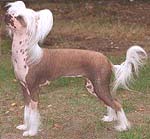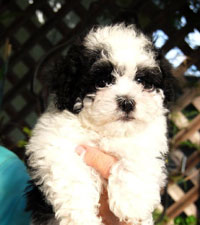Here are the 3 basic steps to clean your dog’s face:
- Gently wash the skin around the eyes using a fresh piece of moistened cotton or make-up remover pad for each one. If you notice any discharge or inflammation, contact a vet for advice.
- Hold open the ear with one hand and gently clean inside the flap with a small piece of moistened cotton or a make-up remover pad. Use a fresh piece for each ear. Do not probe too deeply into the ear canal.
- Loose facial skin must be cleaned regularly with damp cotton. This prevents dirt, dead skin, and bacteria from collecting in the folds and causing irritation and infection
For more info please click here
 Also known as: Chinese Edible Dog, Chinese Hairless Dog, Chinese Ship Dog, Chinese Royal Dog, Hairless Chinese Cresteds, Powderpuff Chinese Cresteds
Also known as: Chinese Edible Dog, Chinese Hairless Dog, Chinese Ship Dog, Chinese Royal Dog, Hairless Chinese Cresteds, Powderpuff Chinese CrestedsAbout Chinese Crested
Country of Origin, History of the breed
The Chinese Crested originated in Africa. This breed of dog is said to have been originally bred from African hairless dogs. The Chinese Crested was used as currency throughout the world; they were traded by sailors and merchants who traveled internationally. The Chinese Crested was one of the favored breeds of dogs due to its small size and its ability to catch vermin aboard ships and in busy port cities throughout Africa, Asia, Central America, and South America.
A General Appearance of the Dog
The Chinese Crested has been bred into two types: the Hairless and the Powderpuff.
The Hairless is distinguished by its hair, which appears on its head, feet, and tail. The powderpuff is a rare form of the Chinese Crested breed.
The Powderpuff is distinguished by the hair that completely covers its body.
The Chinese Crested has a physically compact body which is heavyset; however, the Chinese Crested is sturdy and is well balanced. The Chinese Crested walks gracefully and is known to be a dedicated, playful companion. In addition, the Chinese Crested is known to coexist very well with other animals.
Coat
The Chinese Crested has been bred to display four colors: reddish brown, beige, black and tan, and solid black.
The Chinese Crested may display a reddish brown coat that also has black tones at the chin and whiskers. The beige coat is a mix of reddish brown and black, with a black mask and whiskers. The black and tan coat will display black and reddish brown colors that are seen above the eyes, under the chin, and on the legs. The black coat is a solid colour throughout the dog’s body, with a natural “frosting†on the muzzle of the mature Chinese Crested.
The hairless Chinese Crested displays long, soft tufts of hair that are only seen on the feet, head, and tail. The powderpuff Chinese Crested displays an outer coat with long, straight hair; the powderpuff also has an undercoat that is smooth, fine, and soft.
Height: 9 to 13 inches.
Weight
The average weight of the Chinese Crested is from 5 to 10 pounds; the weight of this breed should not exceed 12 pounds.
Personality
The Chinese Crested has a personality that is affectionate, alert, calm, entertaining, and intelligent. In addition, the Chinese Crested can be playful and will become excited at the prospect of eating a meal or having a between-meal treat. The Chinese Crested can be an astute watchdog, and it displays a non-aggressive attitude toward strangers.
Temperament of the Dog
This breed is suitable for families as it is not aggressive toward young children, adults, or animals. The Chinese Crested is a “home bound†dog, and it does not exist well in a kennel. This is a breed that co-exists very well in a family environment and may experience separation anxiety when removed from familiar people or surroundings.
The Chinese Crested requires constant companionship and will become anxious, noisy, or destructive if left alone for more than a few hours. This breed will not do well in a home with people who are frequently absent. The Chinese Crested requires consistent contact with people, sights, and sounds. If the Chinese Crested is denied companionship, it can become resistant and stubborn.
Better suited to an indoor or outdoor lifestyle?
The Chinese Crested is best suited to a home or apartment with constant occupancy and attention. This breed does not enjoy the outdoors.
Are they suited to homes with kids?
This breed enjoys older children. The Chinese Crested is suspicious of small children due to the possibility of unintentional mistreatment. Small children might step on a puppy or accidentally injure it. Also, small children who are loud and move quickly may make the Chinese Crested puppy experience stress that results in shyness or defensive biting.
Training
The Chinese Crested is a breed that is known for its high intelligence. This breed has the tendency to climb or dig when it feels too confined. As a result, the owner of a Chinese Crested may need to install fencing that extends two or three feet into the ground.
Activity Level
This breed is highly active; however, it only requires moderate exercise. The Chinese Crested responds well to regularly scheduled, brief walks outside the home.
Grooming
The Chinese Crested tends to be odorless, but the powderpuff breed requires weekly grooming.
The hairless Chinese Crested requires a regular skin massage, washing, and moisturizing. The skin of the Chinese Crested may burn when it is exposed to prolonged sunlight.
Health and Care
Any toy breed can be fragile and the Chinese Crested is not an exception. Care must be taken to prevent accidental death from sitting or stepping on the dog. In addition, puppies might jump from an owner’s arms or fall to the ground from furniture and be seriously injured or even killed.
Cautions about Breeding the Dog
The Chinese Crested might be born with knee problems, missing teeth, and missing claws.
Litter Size: 2 to 4 pups.
Life Span: 10 and 14 years.
for more info click here
AKC Ranking: 38
Also Known As: Bichon Havanais, Havana Silk Dog, Spanish Silk Poodle, “Circus Dogâ€
Appearance of the Dog

No comments:
Post a Comment